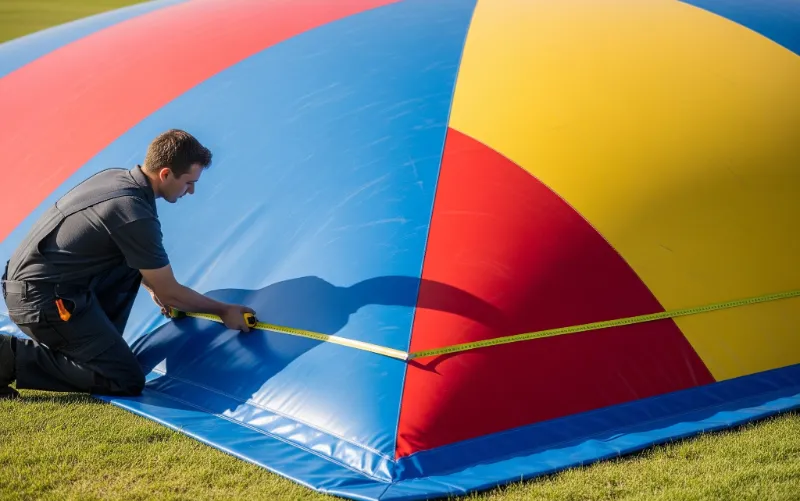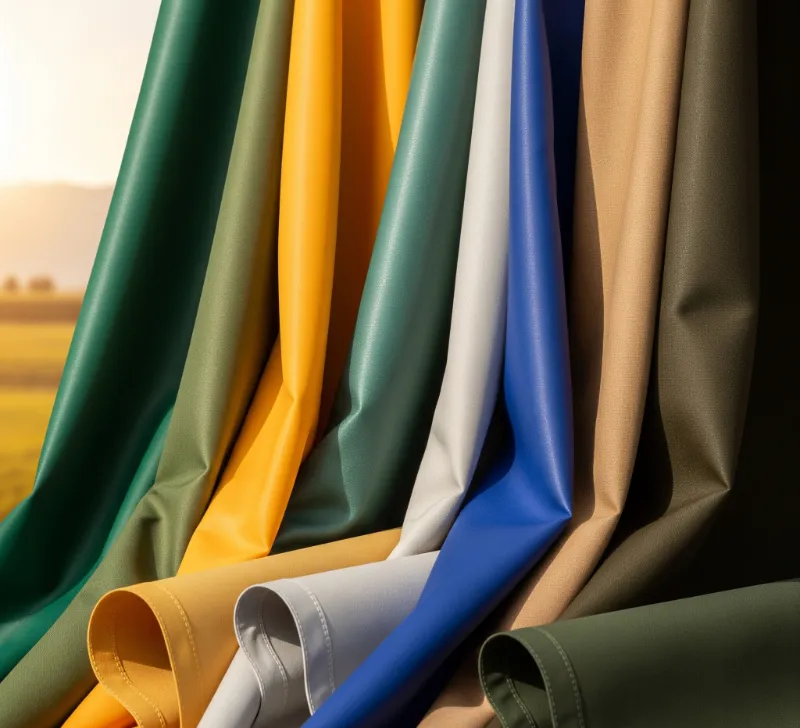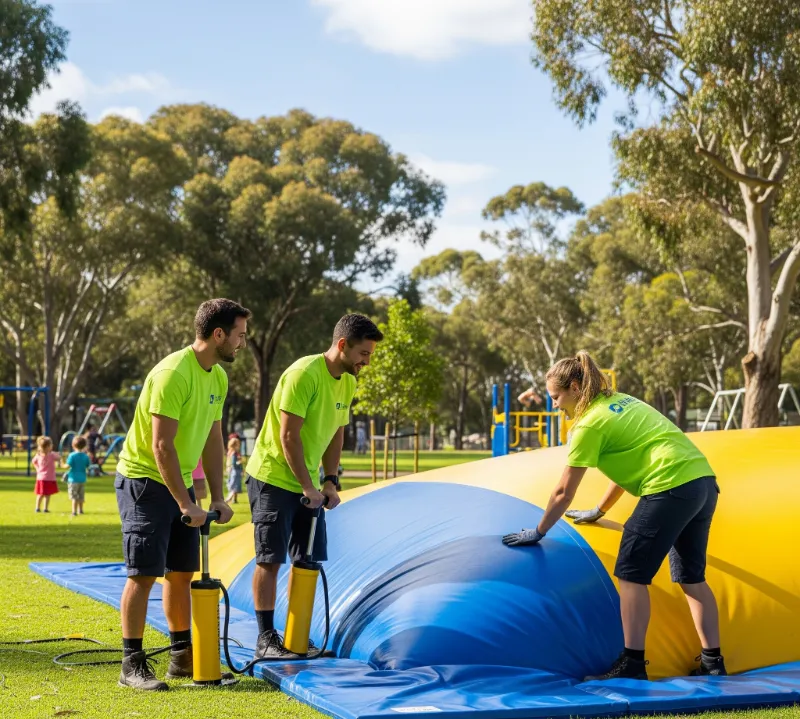How to Cover Your Jump Pillow | Easy Step by Step Guide
Published: 22 Aug 2025
A jump pillow is a large outdoor cushion that people use for fun, play, and exercise. It looks like a giant inflatable bed where kids and adults can bounce safely. Covering your jump pillow is important because it keeps the surface clean, protects it from the sun, and makes it last longer.
A good cover also adds safety by stopping dirt and sharp objects from damaging the cushion. In this guide, you will learn how to cover your jump pillow with simple steps, easy tips, and answers to common questions.
What is a Jump Pillow?
A jump pillow is a big outdoor cushion filled with air that people use for bouncing and fun. It works like a mix of a trampoline and a bouncy castle, but it is stronger and safer for outdoor play. Families often see it in parks, farms, and resorts because it gives both kids and adults a safe place to jump.

Original Jumping Pillows vs DIY Jumping Pillow
There are two common types of jumping pillows:
- Original Jumping Pillows – These are professional-grade cushions made by trusted companies. They are designed with strong fabric, powerful seams, and safe edges. Parks and holiday resorts often choose original jumping pillows because they last longer and meet safety standards.
- DIY Jumping Pillow – Some people prefer to make their own at home. A DIY jumping pillow is cheaper, but it may not be as durable as the original version. People usually try this option for small backyards or private use. It can work well if you use the right fabric and cover it properly, but it still needs extra care.
Examples of Different Jump Pillows
- Big Jumping Pillow – Large models made for parks or schools where many children play at the same time.
- Farm Jumping Pillow – A popular attraction on farms where families visit for fun. Covering these is important because they face dust, mud, and heavy outdoor use.
- Water Jumping Pillow – A floating version placed on lakes or pools. It lets people jump and splash into the water. These pillows always need waterproof covers to stay safe and clean.
Why Do You Need a Cover for Your Jump Pillow?
A jump pillow is a fun outdoor attraction, but it faces dirt, sun, and rough use every day. A proper cover keeps it safe, clean, and comfortable for everyone. Let’s see why a cover is so important.
1. Protection from Dirt, Sun, and Damage
A jump pillow stays outside in open weather. Dust, leaves, and rain can quickly make it dirty. Strong sunlight can also fade colors and weaken fabric. A durable cover protects the jumping cushion from these problems. It works like a shield that keeps the pillow fresh and strong for daily use.
2. Keeps the Jumping Cushion Safe for Longer Use
Without a cover, the surface of the jump pillow wears out faster. A cover adds an extra layer that takes the stress instead of the cushion itself. This means the original jumping pillow lasts longer and gives more value for your money.

3. Makes Cleaning Easier
Nobody likes spending hours scrubbing dirt. A cover makes cleaning simple. You can wipe the surface quickly or wash it with a jumping pillow cleaner. This keeps the pillow ready for safe play in less time.
4. Improves Safety and Comfort
A clean and covered pillow is safer to use. It stops sharp objects, mud, and germs from reaching the surface. It also keeps the surface smooth, so kids and adults can jump without risk. A well-fitted cover also adds comfort, making the jumping cushion enjoyable in every season.
Step-by-Step Guide: How to Cover Your Jump Pillow
Covering your jump pillow is simple when you follow the right steps. As an Outdoor Cushion Cover Specialist, I recommend starting with accurate measurements, using strong fabric, and securing the cover properly. Let’s go through each step.
1. Measure Your Jump Pillow
Start by measuring the full length, width, and height of your jump pillow. Correct size matters because a small cover will not fit, and a loose cover can cause slipping. Always leave a little extra fabric for sewing or fastening. For big jumping pillows, measuring carefully is even more important to avoid fabric waste.

2. Choose the Right Fabric
Pick a fabric that is waterproof, UV-resistant, and durable. The sun, rain, and dust can damage a cover quickly if the material is weak. Outdoor fabrics like PVC-coated polyester or canvas work well. For a farm jumping pillow, choose a fabric that can handle mud and heavy use. For a water jumping pillow, waterproof material is a must.

3. Cut the Fabric Correctly
Lay the fabric flat and mark your measurements with chalk or a marker. Use a sharp pair of scissors to cut along the lines. Beginners should cut slowly to avoid mistakes. Always cut in straight lines, so the cover looks neat when finished.
4. Secure the Cover Firmly
You can secure the cover in different ways. Sewing gives a strong and permanent hold. Zippers make the cover easy to remove and wash. Strong fasteners like Velcro or straps are also good for quick adjustments.
Choose the option that works best for your jump pillow. A diy jumping pillow cover often uses Velcro because it is simple and budget-friendly.
5. Test for Safety and Comfort
After covering your jump pillow, check if the fabric is tight and smooth. Make sure there are no loose ends or folds that can trip jumpers. Press down on the surface and bounce lightly to test the fit. A well-fitted cover will stay in place and make jumping safe.
Real-Life Tip
On a family farm, one owner used a strong waterproof cover for their farm jumping pillow. It kept the cushion clean from mud and dirt, even during the rainy season. In another case, a park replaced a weak fabric with UV-protected material on a big jumping pillow, and the cover lasted two summers without fading.
Jumping Pillow Installation and Covering Tips
Jumping pillow installation looks simple, but it needs care. First, you must choose a flat and safe ground. Many parks, farms, and resorts place their farm jumping pillow on open soil or grass, but a sand base works best for safety.
The pillow connects to the ground with anchors, and a small blower keeps it inflated. Always check the space around the pillow. A clear area helps users jump without risk.

Why Covering is Important During or After Installation
A cover protects your jumping cushion from damage as soon as you set it up. During installation, dust and sharp stones can scratch the surface. A good cover keeps the pillow safe and makes cleaning easier. After installation, a strong cover adds life to your pillow.
It stops the sun from heating the fabric and keeps water away during rain. This is very useful for a big jumping pillow in farms or outdoor parks. If you use a water jumping pillow, a waterproof cover is a must to prevent slipping and damage.
Mistakes to Avoid When Covering
Many owners make small mistakes that cost them later. Here are common issues to avoid:
- Loose Cover: A cover that does not fit tight will move when people jump. This makes the surface unsafe.
- Weak Fabric: Thin fabric tears quickly, especially under sun and rain. Always use UV-resistant, heavy-duty fabric.
- Poor Stitching: Weak seams open fast, and dirt enters the cushion. Strong stitching keeps the cover firm and smooth.
Cleaning and Maintenance of Covered Jump Pillow
Keeping your jump pillow clean and well-maintained helps it stay safe, fresh, and long-lasting. With the right care, you can enjoy more fun and fewer repairs.
Best Way to Clean with Jumping Pillow Cleaner
The safest method is to use a mild jumping pillow cleaner mixed with water. Spray the solution on the surface and gently wipe with a soft cloth or sponge. Avoid harsh chemicals, as they can weaken the fabric or fade the colors.
Daily and Weekly Cleaning Tips
- Daily care: Remove leaves, dust, or small stones from the surface before use.
- Weekly care: Wash the cover lightly with water and cleaner, then let it dry in the shade.
- Monthly check: Inspect stitching, zippers, or straps to make sure the cover stays tight.
Keeping a simple cleaning routine saves you from costly repairs later.
How to Repair Small Tears or Damage in Cover
If you notice a small tear, fix it quickly before it grows bigger. Use a strong outdoor fabric patch or heavy-duty repair tape. Sew the patch tightly if possible. For larger damage, replace the cover or get professional help.
DIY Jumping Pillow Cover Ideas
Making your own jump pillow cover is easier than you think. With the right fabric and a few simple steps, you can protect your jumping cushion at a low cost.
How to Make a DIY Jump Pillow Cover at Home
You can make a DIY jumping pillow cover with simple tools and materials. First, measure the full size of your jump pillow. Then cut fabric that is slightly bigger so it can wrap around safely.
Use a strong thread and stitch the edges, or add zippers for easy removal. If you don’t have a sewing machine, you can also use heavy-duty fasteners or Velcro strips.

Budget-Friendly Fabrics You Can Use
Many people think a cover must be expensive, but that’s not true. For a low-cost option, you can use:
- Outdoor polyester fabric
- Canvas cloth
- Old waterproof tarpaulin These fabrics are cheap, easy to find, and strong enough to protect your jumping cushion. For extra safety, choose UV-protected fabric if your pillow is installed outdoors.
Safety Reminders for Homemade Covers
When making a DIY cover, always keep safety first. Make sure the fabric has no sharp edges or loose threads. Check that the cover fits tightly, because a loose cover can cause tripping.
For a big jumping pillow or farm jumping pillow, double stitching is important. If you use your pillow near water, make sure the cover has a waterproof layer to protect it.
Safety and Durability Tips
Keeping your jump pillow safe and long-lasting is easy if you follow the right steps. These tips will help you protect the cover and enjoy worry-free fun.
Use Strong Stitching for Big Jumping Pillows
Big pillows face more pressure because many people jump at once. Always use heavy-duty thread and double stitching to keep the cover strong.
Add Shade or Roof for UV Protection
The sun can quickly damage fabric and make the surface hot. Adding a shade sail or roof above your pillow protects both the cover and the users. It also makes playtime more comfortable.
Waterproof Coating for Farm and Water Jumping Pillows
If you use a farm jumping pillow or water jumping pillow, waterproofing is a must. You can add a PVC coating or use waterproof spray on the fabric. This keeps the cover safe from rain, splashes, and moisture.
Regular Checks to Avoid Accidents
Covers can get weak over time. Make it a habit to check your pillow once a week. Look for small tears, loose stitches, or dirt. Fixing small problems early prevents bigger damage and keeps your jump pillow safe for everyone.
A magical boho canopy bed adds charm and coziness to any room. Its dreamy design, soft layers, and earthy style create a peaceful space to relax.
Conclusion
Covering your jump pillow is a simple step that keeps it safe, clean, and strong for many years. You measure the pillow, choose the right fabric, and secure the cover tightly. A well-covered jumping cushion stays protected from sun, dirt, and damage.
I remind you that the right cover makes your big jumping pillow, farm jumping pillow, or water jumping pillow last longer and stay fun for everyone. Use this guide to cover your jump pillow with confidence and enjoy safe, long-lasting bouncing.
FAQs – Covering a Jump Pillow
What is the best fabric for a jump pillow cover?
The best fabric is strong, waterproof, and UV-resistant. Outdoor polyester, PVC-coated canvas, or heavy-duty tarpaulin work well. These fabrics protect the jumping cushion from sun, rain, and dirt.
Can I make a DIY cover at home?
Yes, you can make a DIY jumping pillow cover with canvas, tarpaulin, or polyester. Just measure, cut, and stitch the fabric to size. Always check that the cover fits tight and safe.
How often should I clean my jump pillow?
Clean your jump pillow at least once a week.
Use a soft brush and mild jumping pillow cleaner to remove dirt. Regular cleaning keeps it safe, bright, and long-lasting.
Is a cover necessary for farm or water jumping pillows?
Yes, a cover is very important for farm and water jumping pillows. It protects against mud, water, and constant outdoor use. Without a cover, the pillow gets damaged quickly.
How long does a jump pillow cover last?
A good-quality cover lasts 3–5 years with proper care. Regular cleaning and timely repairs extend its life. Strong stitching and waterproof coating make it even more durable.

- Be Respectful
- Stay Relevant
- Stay Positive
- True Feedback
- Encourage Discussion
- Avoid Spamming
- No Fake News
- Don't Copy-Paste
- No Personal Attacks

- Be Respectful
- Stay Relevant
- Stay Positive
- True Feedback
- Encourage Discussion
- Avoid Spamming
- No Fake News
- Don't Copy-Paste
- No Personal Attacks






